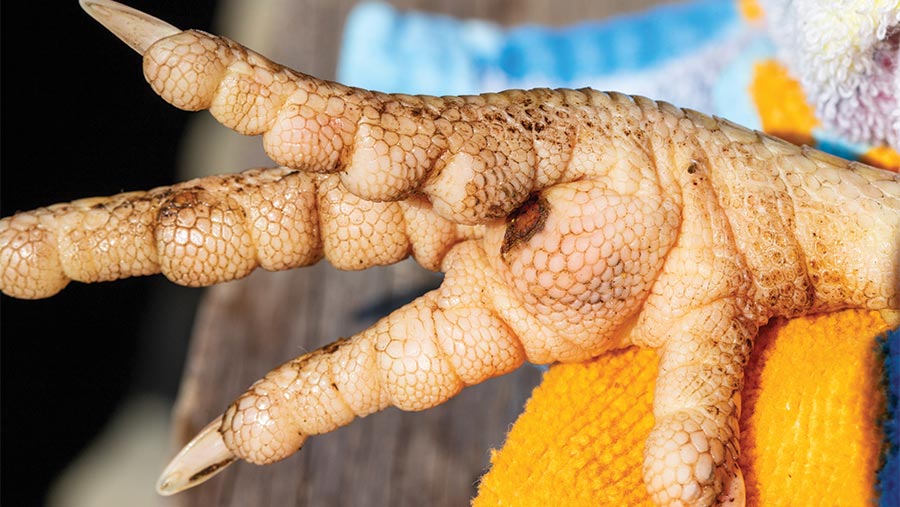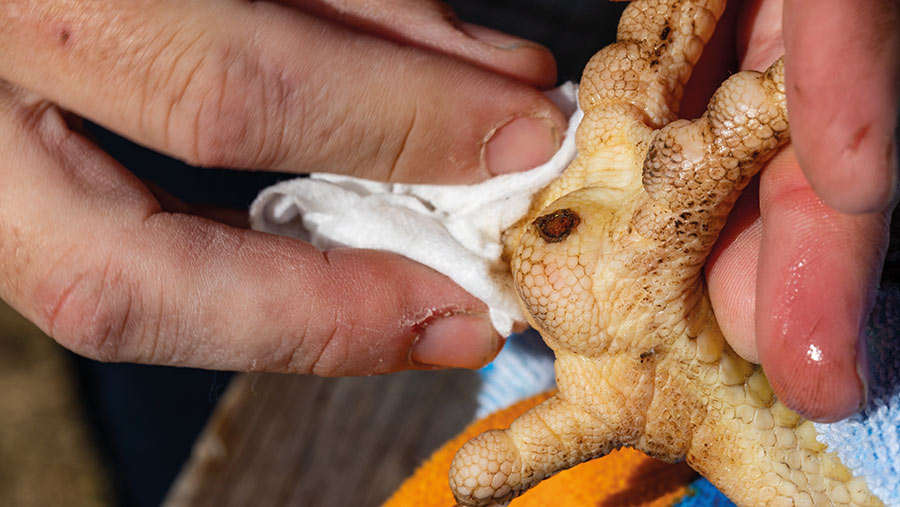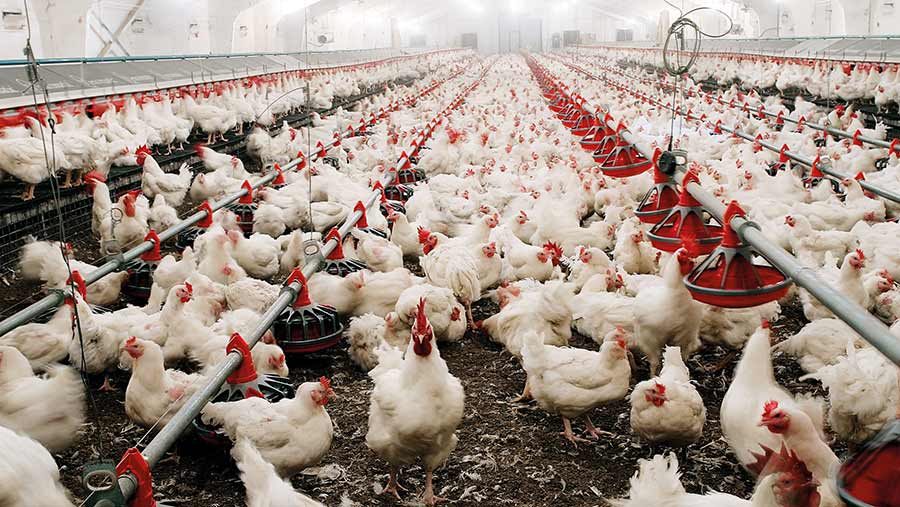4 key actions to help control pododermatitis in broilers
 © C5Media/Adobe Stock
© C5Media/Adobe Stock A chicken’s ability to walk without discomfort is necessary for optimal performance, so maintaining good foot-pad health is not only vital for bird welfare but also for the economic performance of broiler businesses.
Pododermatitis is a non-infectious disease related to a pathological change on the pad of the bird’s foot; there are no medicines to control the condition.
Once established, it will be present in the flock until depletion, so preventing the factors that cause it should be a priority.
See also: How farmers can achieve better broiler leg health
Vet Suzy Brown of Avivets says incidence of pododermatitis has become less common since more producers take a holistic approach to the health management of their birds through improved ventilation, drinking systems and diets.
But as poor gut health, nutrition and shed environment are all factors that can result in an outbreak, flocks are always at risk from the interaction between uric acid in faeces and water becoming an irritant to the foot-pad of the chicken.
“When there is a natural balance between the two, we don’t tend to see problems, but if there is an imbalance, we see some effect on feet,” says Mrs Brown.
If bird health is sub-optimal, gut transit times decrease and this results in too much undigested gut contents being passed straight through the bird, including uric acid, she explains.
“There are many reasons why the gut health can be compromised in the modern-day broiler, and key to solving this is understanding what factors have caused the imbalance.
“They tend to fall under the categories of dietary, disease or environmental factors.”
Prevention means keeping litter under optimal conditions through maintaining good intestinal health and environmental conditions, and having appropriate management practices.
“If there is suddenly an outbreak of wet litter in a shed, is it coming from the bird due to disease or is it an environmental issue like poor ventilation? The two need to be approached quite differently,” advises Mrs Brown.
“First, understand where the problem is originating and plan from there.” There is no “one-size-fits-all” reason for cases of pododermatitis, she adds.
“Some farms might see a high incidence of pododermatitis because their ventilation system is faulty, others are unlucky because they perhaps have the wrong feed or the wrong litter substrate, so every farmer must ask themselves: ‘What is driving the problem on my farm?’.”
While there is no evidence that some breeds are at greater risk of developing pododermatitis than others, Mrs Brown says there is theoretically less likelihood of seeing it in slower growing breeds stocked at a lower density.
“But it depends on the reason behind an outbreak,” she says. “A poorly maintained ventilation system that is not calibrated correctly is not going to cope with the metabolic demands of any modern-day broiler.
But the breed doesn’t have a massive impact; if you were to do other things badly but just changed the breed it wouldn’t necessarily improve the situation.”
1. Spot the signs
Birds are prey animals so they disguise pain well, but if they are not moving around and are not motivated to eat and drink, Mrs Brown recommends picking them up and inspecting their feet for lesions.
If they have foot-pad dermatitis, there will be a scar resembling a dry, brown-and-black scab on the skin. Swelling in the feet is also common.
The severity of the condition can be established using a lesion scoring system:
- Score 0 No lesions or only very small ones, measuring 1-2mm, and slight discolouration and a toughening of the foot-pad
- Score 1 Superficial lesions, significant discolouration of the foot-pad, dark papillae but no ulceration
- Score 2 The foot-pad is severely swollen, has deep lesions, ulceration, a large scab and sometimes haemorrhaging.
Processors usually monitor for pododermatitis, and this is often where it is first spotted, says Mrs Brown.
This can have major consequences for growers so, if they know they have a problem, she advises forewarning their processor.
“The Animal and Plant Health Agency [Apha] will be notified if scores are too high,” Mrs Brown warns.
“If you hit a certain level, Apha will want to see evidence of an action plan of how the situation will be managed and prevented going forward.”
For repeat offenders, if there is an indication that sufficient action is not being taken to remedy the situation, a directive can be made to prevent the farm from stocking birds or to reduce its stocking density to take pressure off the crop.
“They may direct that birds need to be slaughtered sooner than hoped and that has obvious financial implications for the business,” says Mrs Brown.

© C5Media/Adobe Stock
2. Treat or cull
In very severe cases, Mrs Brown advises administering appropriate pain relief, either through nutraceuticals or pharmaceutical interventions. Culling those birds may, however, be the only option.
Promptly top-dressing wet litter is also advised while the source of the problem is investigated.
“Top-dressing will certainly help in the interim but it is just a sticking plaster, it is not going to solve the problem,” says Mrs Brown.
3. Get nutrition right
Diet formulation should match the needs of the flock’s breed and age.
Some ingredients included at the wrong levels will cause diarrhoea or an increase in water consumption – for instance, if the diet is too high in protein or has the wrong concentration and quality of fats.
Consider reducing protein or switching to a more digestible protein.
The amount of water in the faeces can be reduced with lower levels of salt in the diet. The integrity of the skin on the foot-pad can be improved by adding zinc and biotin to the diet.

© ShunTerra/Adobe Stock
4. Maintain shed ventilation
Wet litter is a significant contributory factor and while this can be the result of poor gut health or dietary issues, the blame could lie with faults in the ventilation system, leaky drinkers and pipes, or from condensation.
Even something as simple as very cold water passing through pipes in a heated environment in the winter can result in high levels of condensation, enough to make the litter wet.
“Cold water and very warm sheds can be a problem that needs managing,” says Mrs Brown. She recommends regular maintenance of ventilation systems, to ensure everything is in good working order.
“If there is poor flock performance and a farm has not had pododermatitis before but is getting more cases, ask: ‘Am I bringing enough clean air in and removing enough stale air at the right time and heat that is good for my birds?’.”
While some producers ventilate according to age-based weight, Mrs Brown advises against this. “It is better to have it set up to ventilate on actual weight because it is better for metabolic health.”
